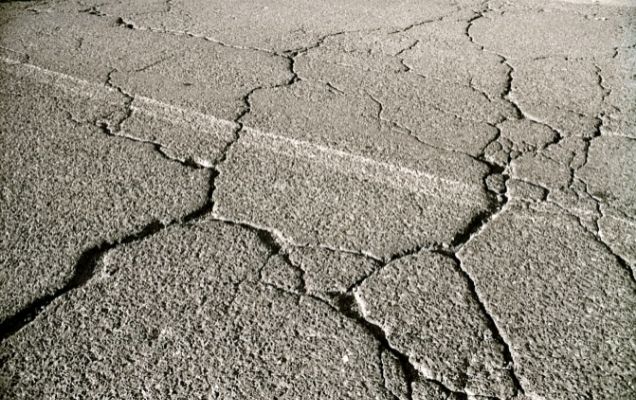Understanding Chemical Exposure and Its Impact on Asphalt Degradation
by siteadmin

Asphalt surfaces, whether they’re roads, driveways, or parking lots, endure a myriad of challenges daily, from vehicular traffic to the forces of nature. However, one often overlooked factor that can significantly contribute to asphalt degradation is chemical exposure. In this blog post, we’ll delve into the effects of chemical exposure on asphalt and explore preventative asphalt maintenance strategies to mitigate damage and prolong pavement lifespan.
The Role of Chemical Exposure
Chemical exposure on asphalt surfaces can come from various sources, including:
- Vehicle Fluids: Oil, gasoline, brake fluid, and other automotive fluids can leak onto asphalt surfaces, leading to chemical reactions and degradation.
- De-icing Agents: Chemicals used for snow and ice removal, such as salt (sodium chloride) and calcium chloride, can penetrate asphalt and accelerate deterioration.
- Cleaning Agents: Harsh cleaning chemicals and solvents used for maintenance purposes can also impact asphalt integrity.
Understanding Asphalt Degradation
Chemical exposure can cause several forms of asphalt degradation:
- Surface Erosion: Chemicals can dissolve the asphalt binder, leading to surface erosion and the formation of potholes, cracks, and raveling.
- Cracking: Certain chemicals can penetrate the asphalt, causing it to become brittle and prone to cracking, especially in areas with freeze-thaw cycles.
- Color Fading: Exposure to chemicals and UV rays can lead to discoloration and fading of the asphalt surface, affecting its aesthetic appeal.
- Weakening of Binders: Chemicals can weaken the bonds between asphalt aggregates and binders, compromising the pavement’s structural integrity.
Preventative Asphalt Maintenance
To mitigate the impact of chemical exposure on asphalt degradation, preventative maintenance is key. Here are some effective strategies:
- Regular Cleaning: Promptly remove spilled fluids, debris, and other contaminants from the asphalt surface to prevent chemical penetration and damage.
- Sealcoating: Applying a protective sealcoat to the asphalt surface forms a barrier that shields against chemical exposure, UV rays, and water infiltration.
- Proper Drainage: Ensure adequate drainage systems to redirect water runoff away from the asphalt surface, reducing the risk of chemical accumulation and moisture-related damage.
- Use of Chemical-Resistant Sealants: When sealing cracks or joints, use chemical-resistant sealants specifically designed to withstand exposure to automotive fluids and other chemicals.
- Timely Repairs: Address cracks, potholes, and other pavement defects promptly to prevent further deterioration and minimize the risk of chemical infiltration.
- Limiting Chemical Usage: Minimize the use of harsh cleaning agents and chemicals near asphalt surfaces to reduce the risk of damage.
Importance of Preventative Asphalt Maintenance
Implementing preventative maintenance measures is essential for preserving the integrity and longevity of asphalt surfaces. By proactively addressing chemical exposure and its effects, property owners can:
- Prolong Pavement Lifespan: Preventative maintenance helps extend the lifespan of asphalt surfaces, reducing the frequency of costly repairs and replacements.
- Maintain Aesthetic Appeal: Regular maintenance preserves the appearance of asphalt surfaces, enhancing curb appeal and property value.
- Ensure Safety: Well-maintained asphalt surfaces are safer for pedestrians and vehicles, minimizing the risk of accidents and injuries.
- Reduce Long-Term Costs: Investing in preventative maintenance now can save money on extensive repairs and replacements in the future.
Chemical exposure poses a significant threat to asphalt surfaces, contributing to degradation and structural deterioration over time. However, with proactive preventative asphalt maintenance, property owners can mitigate the effects of chemical exposure and prolong the lifespan of their pavement. By implementing regular cleaning, sealcoating, timely repairs, and other preventative measures, asphalt surfaces can remain durable, attractive, and functional for years to come. Prioritizing preventative asphalt maintenance is not just about preserving pavement, it’s an investment in the long-term sustainability and safety of your property.
Interested in delving deeper into asphalt? Here’s another article tailored to your curiosity! Exploring the Chemical Composition and Advantages of Asphalt Cold Seal
Asphalt surfaces, whether they’re roads, driveways, or parking lots, endure a myriad of challenges daily, from vehicular traffic to the forces of nature. However, one often overlooked factor that can significantly contribute to asphalt degradation is chemical exposure. In this blog post, we’ll delve into the effects of chemical exposure on asphalt and explore preventative…
Recent Posts
- Balancing Act: Environmental Impact and Sustainability in Asphalt Paving
- Smooth Moves: Asphalt Paving Maintenance Strategies for Sustaining Smoothness
- Innovating Asphalt Paving: Exploring Advanced Asphalt Mix Design Methodologies
- The Importance of Pothole Repair: Health Impacts of Pothole-Related Accidents
- Understanding Chemical Exposure and Its Impact on Asphalt Degradation
